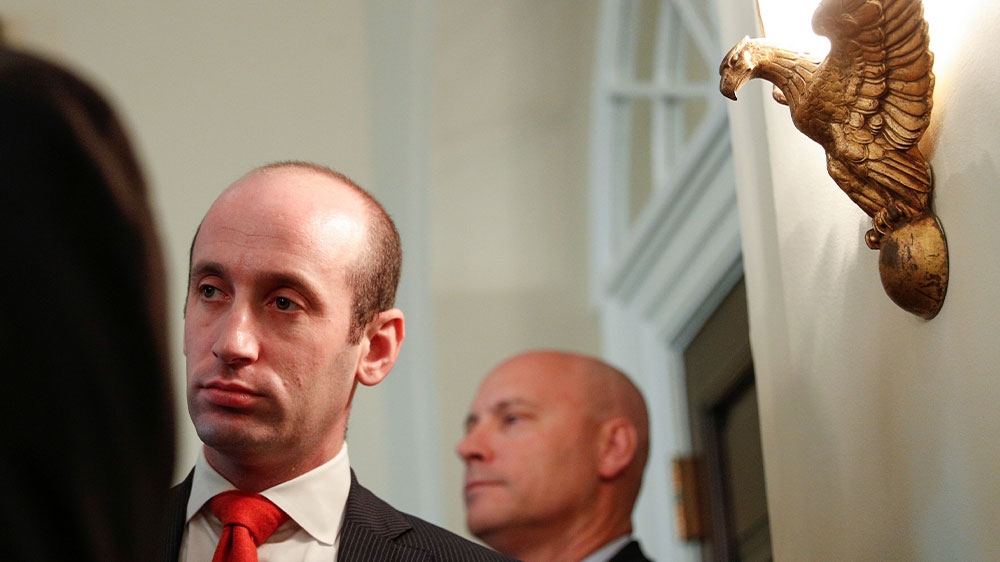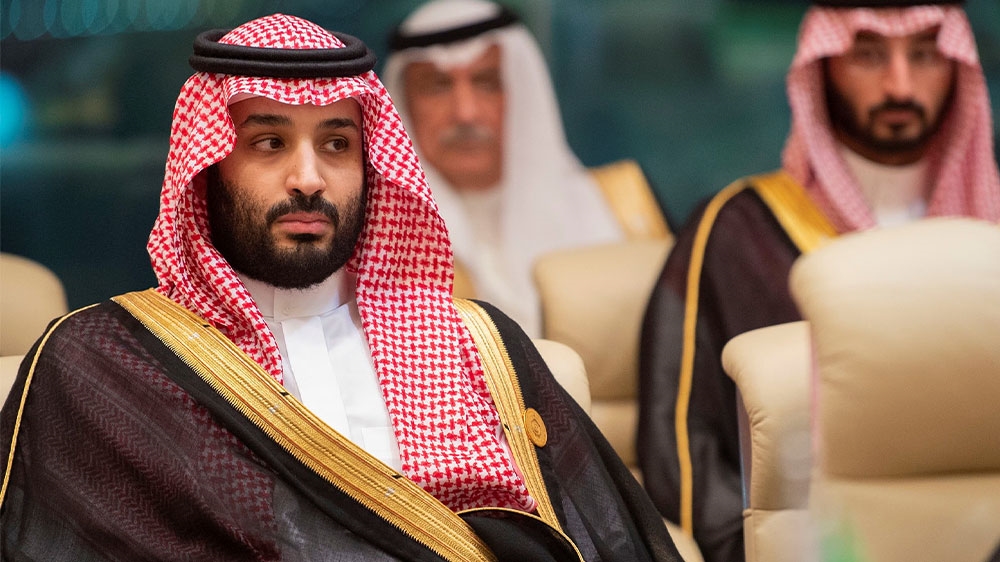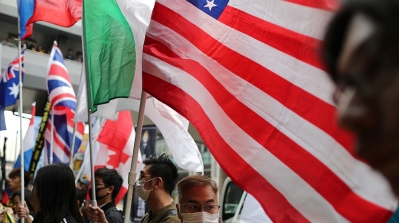10 things the Trump administration did in 2019 that you may have missed
From slashing the refugee cap to weakening climate policy, here are some of the things Trump did last year that you may have missed.

Washington, DC – It was another turbulent year for US President Donald Trump.
From the conclusion of the FBI investigation into allegations his 2016 campaign colluded with Russia to his impeachment, Trump may have spent as much time defending his presidency and actions as he did governing in 2019.
Keep reading
list of 4 itemsTrump faces Supreme Court immunity test as ‘hush money’ trial continues
Five takeaways from day two of Trump’s New York hush money trial testimony
‘Catch and kill’ scheme takes centre stage at Trump hush-money trial
But there were also many decisions his administration made that did not get as much attention.
Here are the top 10 things the Trump administration did that you may have missed:
1. Top adviser with white nationalist ties?
Stephen Miller, a top adviser to Trump, has been a driving force behind Trump’s immigration policies. A former Senate aide, Miller joined Trump’s campaign early in the primary season and has helped shape much of the administration’s domestic policies.
Miller is considered one of the architects of Trump’s so-called Muslim ban which prohibits the entry into the US of citizens from five Muslim-majority countries, Iran, Libya, Somalia, Syria and Yemen, and restricts a small number of North Koreans and Venezuelans from coming into the country. He was also one of the main proponents of the US’s practice of separating undocumented migrant children from their parents at the US southern border.
But Miller has also been accused of having ties to white nationalist organisations. According to a November investigative report by the Southern Poverty Law Center (SPLC), a US-based watchdog group, prior to taking the White House job, Miller regularly sent reporters links to white supremacist groups as “research” to back his arguments on immigration. This included a number of emails sent to right-wing website Breitbart. A White House official defended Miller, saying he “hates bigotry in all forms” despite calls from members of Congress to fire him.

The SPLC report came a few months after an underreported incident when the Department of Justice (DOJ) sent out an email to employees with a link to a white nationalist organisation. A DOJ official said the email was a mistake.
“The daily EOIR [Executive Office for Immigration Review] morning news briefings are compiled by a contractor and the blog post should not have been included,” the official said.
2. Nuclear technology to Saudi Arabia
As the US persistently shakes its finger at Iran and North Korea for attempting to develop a nuclear weapons programme, it quietly okayed the sale of nuclear technology and expertise to Saudi Arabia, which plans to build at least two nuclear power plants. In March, reports revealed that the US had secretly approved six authorisations for companies to sell nuclear power technology to Saudi Arabia.
But as tensions simmer between the Saudi kingdom and its regional rival Iran, there is widespread concern that sharing nuclear technology with Riyadh could lead to a nuclear arms race in the Middle East. Concerns were compounded after Saudi Crown Prince Mohammed bin Salman (MBS) said in a 2018 interview that he would develop nuclear arms if Iran did.

Trump, meanwhile, has been exercising a “maximum pressure” campaign against Iran after he withdrew the US from a 2015 nuclear pact that curbed Iran’s nuclear programme in exchange for sanctions relief.
Read more here.
3.Trump replaces Obama-era climate change plan
Trump ran on a campaign promise to overturn environmental restrictions on major industries put in place by his predecessor Barack Obama. Trump has been particularly vocal in his protection of the coal industry, public enemy number one for many environmentalists when it comes to fighting climate change.
In June, the Trump administration officially ended the Clean Power Plan (CPP). Put in place by the Obama administration in 2015, CPP aimed to slash power plant carbon emissions by more than a third by 2030 by pushing utilities to drop coal in favour of cleaner fuels like natural gas, solar and wind power.
The Trump administration argued it was an example of overregulation, restricting American companies’ ability to compete globally. It replaced CPP with the Affordable Clean Energy rule which does not curb rising carbon emissions from power plants and prolongs the operation of coal plants.
Twenty-two states are now suing the federal government, arguing it prolongs US reliance on coal power and obstructs states that pursue cleaner electricity generation.
“The coal lobbyists and climate deniers running the Trump administration wrote every word of this illegal and dangerous rule,” argued Massachusetts Attorney General Maura Healey, one of the state officials leading the lawsuit.
In November, the Environmental Protection Agency took Trump’s plan one step further by announcing it wants to roll back regulations on waste from coal plants, sparking fears that small communities around the US would be more vulnerable to adverse health effects.
Read more here.
4. IG says State Department targeted employee over ethnic background
The State Department’s inspector general issued a report in November that found an employee of the department was improperly removed from her post by officials over her ethnic background, perceived political views and prior role in the Obama administration.
Sahar Nowrouzzadeh is a State Department security specialist who was born in Connecticut but whose parents immigrated from Iran. The report found that employees in the administration had circulated conservative news articles with false claims that she was born in Iran and was a “Muslim spy”. Nowrouzzadeh was demoted by the department under the guidance of US special representative for Iran, Brian Hook, who denied the decision was based on her background. But the IG drew a different conclusion and recommended discipline for a number of high-ranking state department officials.
The report is the second by the IG on the topic of political retaliation. An earlier report in August found that two Trump-appointed officials had routinely disparaged career employees for their perceived political opinions and work for the previous administration.
5. Trump slashes US refugee cap
Trump has made slashing immigration a central focus of his presidency and re-election campaign. The number of refugees admitted into the US has hit historic lows since he took office. In the 2019 fiscal year, 30,000 refugees were admitted in the country, a record low. And the State Department announced in September that it will cap the number of refugees allowed in the country in 2020 at 18,000, the lowest number since the resettlement programme was created in 1980.
The Trump administration also granted states and counties the right to block any refugee resettlements within their jurisdiction.
Officials said there are too many cases for courts and agents to handle. “The overwhelming backlog is completely unsustainable and needs to be addressed before we accept large numbers of refugees,” a White House statement said.
Read more here.
6. Middle East peace summit in Bahrain
Trump’s plan to negotiate a peace deal between Palestinians and Israelis has stalled repeatedly since he took office. In February, 2017, Trump stood with Israeli Prime Minister Benjamin Netanyahu at the White House and promised, “We’ll be working on it very, very diligently.”
He put his son-in-law and top adviser, Jared Kushner, on the case. Since then, Kushner has travelled to the region multiple times.
The Trump administration has unveiled a $50bn economic plan to end the decades-old conflict between Israelis and Palestinians. In June, Kushner opened a two-day conference in Bahrain to rally support for the plan, which expects donor nations and investors to contribute funds towards projects in the occupied Palestinian territories, as well as Jordan, Egypt and Lebanon.

Palestinian leaders rejected the plan and boycotted the conference, accusing it of pro-Israel bias after it shut down its consulate in Jerusalem and ordered the Palestinian mission in Washington, DC, to close. Earlier in 2019, the US cut all aid to the Palestinian territories.
Critics say Kushner’s attempt to decide economic priorities first while initially sidestepping politics ignores the realities of the conflict.
The political portion of the peace plan has not been released.
Read more here.
7. Pushing South Korea to China
The US has held troops in South Korea since the ceasefire between North and South Korea in 1953. In 1991, Washington and Seoul signed the Special Measures Agreement (SMA), which lays out how the two countries cover the costs associated with protecting the Korean Peninsula.
The SMA was scheduled to expire at the end of 2019 and Trump reportedly took the opportunity to increase the price tag. In August 2019, Trump tweeted that South Korea was not paying its fair share. In November, talks between the two countries over burden-sharing broke down after the US reportedly asked for five times the amount from Seoul to keep American troops there. That same week, South Korea signed an agreement with China for more military cooperation, pushing a close US ally towards a US adversary.
8. Conflict-of-interest woes
Trump, a former businessman, often compares the running of government to running a business. But he has repeatedly come under fire for using his position as president to promote his businesses, many of which bear his name on them.
In September, the US Air Force came under scrutiny after it was revealed that crews had been staying at Trump’s Scottish resort in Turnberry during stopovers, ignoring cheaper options. A Pentagon investigation concluded the stays were within guidelines.
In October, another report surfaced he was pushing to have the G7 summit at his golf resort in Doral, Florida. Trump cancelled the plan after significant backlash, but was puzzled over why it was such a big deal. “I was willing to do this for free,” Trump told reporters during a cabinet meeting.
He used the meeting to rail against what he calls, “this phony emoluments clause”, an article in the US constitution that forbids the president from accepting gifts or “emoluments” from foreign leaders while in office.
In July, a federal appeals court threw out an emoluments case against him that argued profits from his Washington hotel were a violation of the clause.
9. Trump signs Hong Kong legislation
The Thanksgiving holiday in the US is a good time for presidential administrations to bury news. In November, Trump used the holiday to sign the Hong Kong Human Rights and Democracy Act. The legislation, passed by Congress, followed months of mass pro-democracy protests that rattled the Chinese government. The legislation threatens to bar entry of individuals who “violate internationally recognised human rights”.

But the legislation also put Trump in a political bind. It came as the US and China held talks on a possible trade deal. Beijing said it “seriously interfered with Hong Kong affairs, seriously interfered with China’s internal affairs, and seriously violated international law and basic norms of international relations”. Trump said he supported the pro-democracy protesters, but China was “a friend”.
The legislation also passed with veto-proof majorities in both houses of Congress.
10. Debt and deficit grow
As a businessman-candidate for the White House in 2016, Trump promised to use his experience to get rid of the national debt “within eight years” if elected.
But as president, the US national debt has soared.
In January 2017, when Trump took office, the debt hovered around $19 trillion. As of December 2019, that total is just over $23 trillion, a 21 percent increase. The federal deficit continues to grow with massive spending on the US military causing a large portion of it.
In 2019, the deficit was its biggest in seven years with an even bigger one projected in 2020. Trump promised a 2017 tax cut would help pay down the debt and deficit as the economy improved.